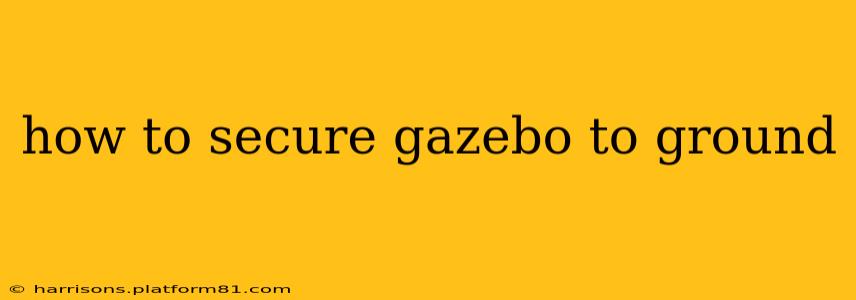Choosing the right gazebo for your backyard oasis is just the first step. Ensuring its stability and longevity requires proper anchoring to the ground. A poorly secured gazebo can become a hazard in high winds or heavy rain, potentially causing damage to your property or even injury. This comprehensive guide will explore various methods to securely fasten your gazebo, ensuring it remains a safe and enjoyable addition to your outdoor space.
What are the Best Ways to Secure a Gazebo?
The best method for securing your gazebo depends on several factors, including the gazebo's size, weight, material, and the type of ground you have. Here are some of the most common and effective anchoring techniques:
-
Ground Stakes/Auger Anchors: These are ideal for soft ground like soil or sand. Auger anchors are particularly effective as they create a strong, deep hold. Simply drill them into the ground and attach the gazebo's weight plates or anchoring points using straps or bolts.
-
Concrete Footings: This is a more permanent solution, best suited for larger, heavier gazebos or areas prone to strong winds. Concrete footings offer exceptional stability, but require more effort and time to install. They involve digging holes, setting the forms, pouring concrete, and then attaching the gazebo’s base.
-
Ground Screws: Similar to auger anchors, ground screws offer strong anchoring in various ground conditions. They're particularly beneficial where digging is difficult or restricted. Their advantage lies in their reusability and ease of removal if needed.
-
Weight Plates: While not a true anchoring method, heavy weight plates placed on the gazebo's legs can provide added stability, particularly in less windy areas. These work best in conjunction with other anchoring methods.
-
Using Existing Structures: If your gazebo is situated near a fence, patio, or deck, you can often tie it down to these structures for added security.
How Deep Should Gazebo Anchors Be?
The depth of your anchors depends on the ground conditions and the gazebo's size and weight. As a general rule, anchors should penetrate the ground at least 12-18 inches for optimal stability. In areas with loose soil or strong winds, you may need to go even deeper.
What Materials are Needed to Secure a Gazebo?
The specific materials you'll need depend on your chosen anchoring method. However, some common items include:
- Auger anchors or ground screws
- Concrete mix (if using concrete footings)
- Post hole digger or auger drill
- Measuring tape and level
- Shovel (if digging holes)
- Heavy-duty straps, bolts, or tie-downs
- Safety glasses and work gloves
How Do I Secure a Gazebo on Concrete?
Securing a gazebo on a concrete patio or slab requires a different approach than soft ground. You might consider:
- Concrete anchors: These are specialized anchors designed to be embedded in concrete. They offer a strong and permanent solution.
- Weight plates: Placing heavy weight plates on the gazebo's legs can add stability, although this alone isn't sufficient for strong wind conditions.
- Drilling and bolting: If the gazebo's base has pre-drilled holes, you can drill corresponding holes into the concrete and bolt the gazebo directly to the slab. This requires specialized drilling equipment and expertise.
What if I Have a Pop-Up Gazebo?
Pop-up gazebos are generally lighter and less sturdy than permanent gazebos. For these, you should prioritize:
- Weight plates: These are essential for pop-up gazebos, adding significant weight to prevent wind damage.
- Ground stakes: These provide additional stability, particularly when combined with weight plates.
- Avoid windy conditions: Pop-up gazebos should always be taken down during high winds.
By carefully considering your specific needs and following the appropriate anchoring techniques, you can ensure your gazebo is securely fastened to the ground, providing years of enjoyment and protection from the elements. Remember to always prioritize safety and consult with a professional if you are unsure about any aspect of the installation.
